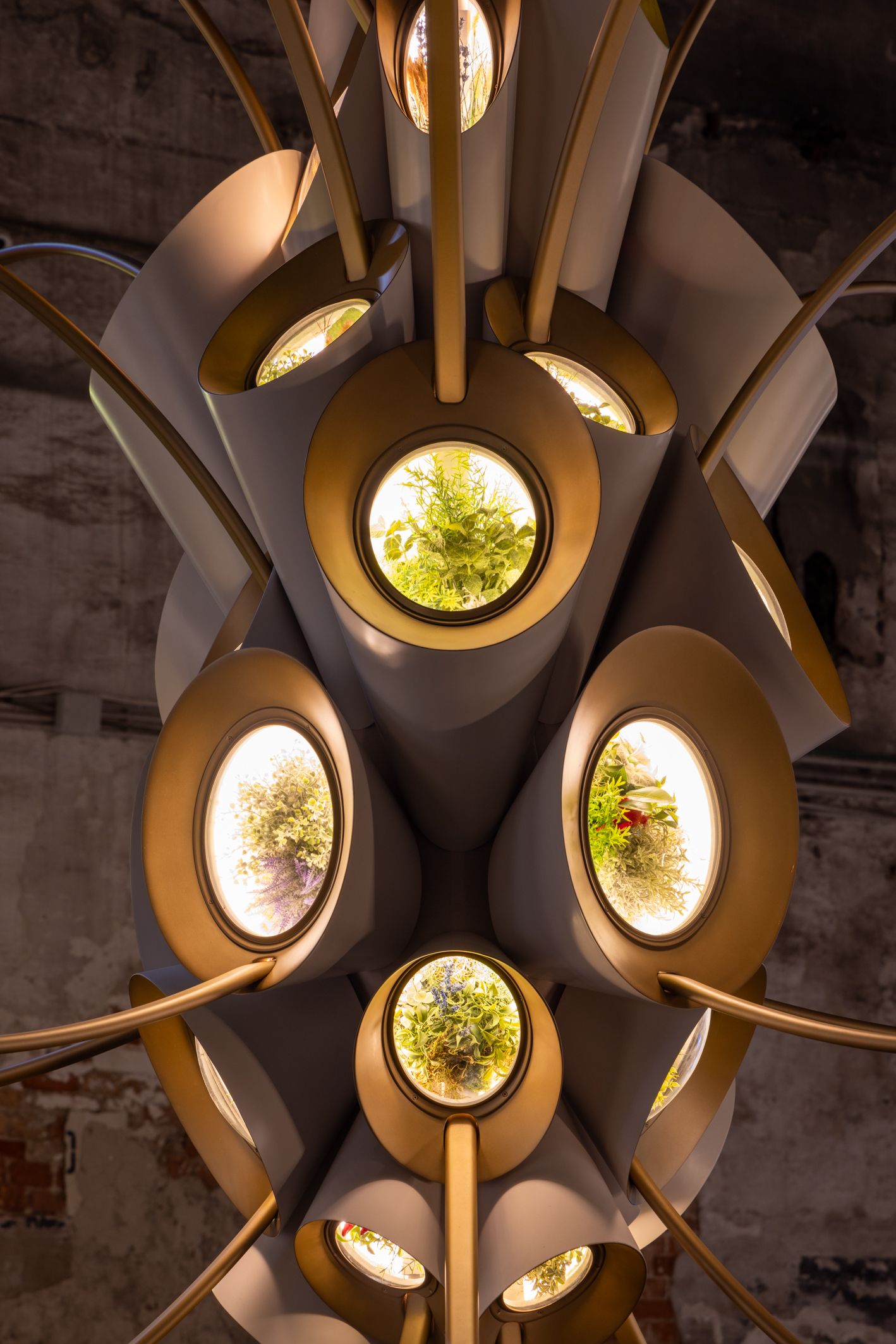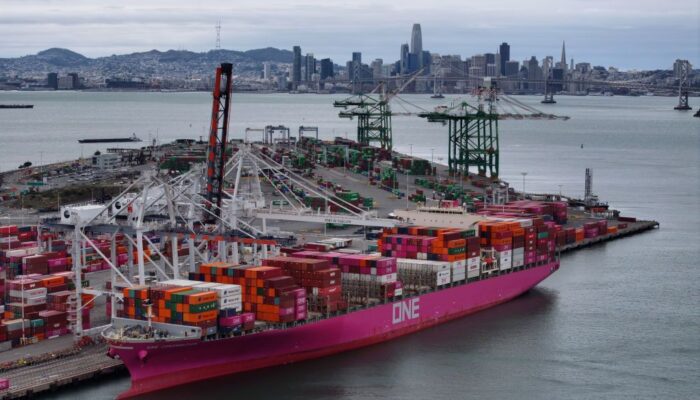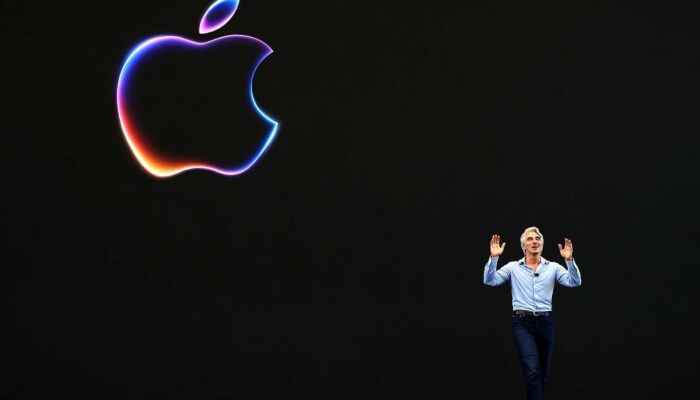All products featured on WIRED are independently selected by our editors. However, we may receive compensation from retailers and/or from purchases of products through these links.
It looks like some kind of seed pod or pine cone caught mid-explosion. At the center, there’s a jumble of trumpets-turned-terraria—conical containers for space-going plants—and from this central core extend more than two dozen curved and spindly arms, each with a heavy-looking disc at its end.
This is a Space Garden. Well, a one-third-scale model of one that was exhibited last week at the Venice Biennale exhibition in Italy. The people who came up with Space Garden want to send a full-size version, stocked with real plants and seeds, to low Earth orbit within the next five to seven years.
It is, in part, an effort to reimagine what life in space could be like. “People will commute to space for work,” asserts Ariel Ekblaw, CEO of Aurelia Institute, a nonprofit space architecture design lab. And they’re going to appreciate having some greenery around when they get up there, she adds. “If we start with nature, we might go on a more fruitful pathway to a life worth living in space,” explains Stuart Wood, executive partner at Heatherwick Studio, a London-based design and architecture firm that is collaborating with Aurelia Institute on the Space Garden project.
For decades, astronauts have dabbled in space gardening. Russian cosmonauts were the first to grow plants in space during the 1970s—their crops included onions, some of which were later eaten by residents aboard the Salyut 1 space station. Other orbital adventurers have grown thale cress, tomatoes, zinnias—and a Chinese probe even carried cotton seeds to the far side of the moon in 2019. Two weeks post-landing, the seeds had sprouted (but, ahem, they soon froze to death during the outrageously cold lunar night).
While off-world agriculture has long seemed nascent and experimental, that could soon change. Researchers are currently pushing plants and seeds to extraordinary limits, to test their space-hardiness—often with encouraging results. Space-travelling vegetation must battle cosmic radiation, uneven temperatures, air that isn’t quite like the air on Earth, and many other challenges.
Intrepid flora could help otherwise artificial and sterile environments—space stations, pods, and capsules—seem more like home, though. The designers of Space Garden say it’s time orbital horticulture took a quantum leap, something like the giant interstellar greenhouses of the film Silent Running. They want to include “hero” species at the center of their cosmic garden, chosen for their aesthetic or cultural significance, in order to connect rocket men and women with the beautiful Earth below. Perhaps a small fig or pomegranate tree, for example. “It’s not all watercress and lettuce,” says Wood.
But the journey, invariably, begins with seeds. People who want to boldly sow where no-one has sown before already have a wealth of studies to pore over. And quite a few of them have been carried out by Mike Dixon at the University of Guelph in Canada, and colleagues. Dixon has sent literally millions of seeds into space over the years. Generally, once back on Earth, they germinate without problems.
In 2021, he and others sent seeds to the International Space Station (ISS). While in space, they were contained within a contraption positioned outside the cocoon-like environment of the space station itself, a suitcase-shaped enclosure called the Materials International Space Station Experiment (MISSE). “Quite frankly, I didn’t expect the ones outside the space station to survive,” says Dixon. But they did. The seeds were exposed to some cosmic radiation, but being in a shaded position aboard MISSE, they were spared the worst of the rays, and their temperature never exceeded 50 degrees Celsius. Truly direct sunlight in the vacuum of space can be incredibly intense.
Research also suggests that, once plants sprout in space, they might cope with a fair amount of interstellar abuse. They don’t mind reduced pressure and oxygen levels, says Dixon. And while temperatures must be kept within a reasonable threshold—consider those short-lived cotton plants on the moon—plants are more tolerant of such variation than mammals, including humans, says Dixon: “Plants won’t be the limitation in our exploration of space—it’s us. We’re kind of wimpy in many respects.”
But space gardeners will still need to be conscientious growers. Ye Zhang of NASA’s Kennedy Space Center has carried out extensive research on space-going seeds and has noticed differences in the hardiness of certain species. “Tomatoes and lettuces are sensitive to the space environment, especially,” she says, referring to previous work. In 2021, she and colleagues also sent seeds to MISSE, which after eight months returned to Earth. They were held in little foil-lined packets, just like the seed packets you buy at garden centers. All of the seeds, for various different plants including kale, radish, and carrot, germinated reliably, suggesting that their position within the MISSE device was protective enough to ensure seed survival.
As for actually cultivating large numbers of plants in orbit in the future, a key challenge will be water management, suggests Zhang, noting that plants’ uptake of water might vary in space: “Overwatering will stress the plants, and then the plants will be more susceptible to microbial or other problems.” Separately, seeds can clearly survive the powerful vibrations of a rocket launch, but certain established plants might not. Plus, it remains an open question as to how certain plants will fare on really long space voyages that last, say, multiple years.
Zhang adds that further research will help us understand how space travel changes the genes in seeds and plants, since that could significantly affect how they grow. There are already hints that genes related to plants’ immune systems turn on or off in space—which might influence their resistance to infections, for example.
A concept such as Space Garden, however, peers past these details to a future where the intricacies of off-world horticulture are largely solved. For Ekblaw and her colleagues, the vision depends partly on spaceflight becoming far more accessible than it is today. Launching things into orbit is going to have to get a lot cheaper and fall from thousands of dollars per kilogram at present to perhaps as little as $100–200 per kilogram, which some analysts predict will happen. “That’s like Fedex, that’s like DHL,” says Ekblaw.
She imagines industrial activity in space, freeing up land on Earth. Hollywood directors shooting films in orbit. And botanists traveling back and forth to check on their Space Gardens. She and her colleagues are currently seeking funding to help make their concept a space-going reality. The model, made by London-based design firm Millimetre, is for display only. A real version, if it ever flies, would also be uninhabited by humans, at least initially. I ask why her team was so desperate to come up with an aesthetically pleasing design, in that case. It’s “something that can recapture the public’s imagination,” she explains.
Space Garden with its appendages closed.
Photograph: Raquel Diniz
These can be opened to give the garden’s plants access to light.
Photograph: Raquel Diniz
But is it practical? The thin, lobe-bearing arms that protrude from Space Garden look very fragile. Ekblaw says these telescopic appendages will typically be retracted. “Most of the time, the structure looks a little more like a berry—without those spindly arms,” she adds. When closed, the lobes will shield plants at the center, behind their thick windows, from light—but the structure can open up in order to let light reach the plants. It’s a mechanically controlled alternative to Earth’s day-night cycle.
Eventually, Ekblaw suggests, astronauts might occasionally stop by Space Garden to collect samples from it. Open-source data tracking the environmental conditions on board, and plant growth rates, would also add to our understanding of how to cultivate food successfully in space, she says.
When I show Space Garden to Dixon, he says it looks “fancy” and immediately opines that there might not be much need to grow food in space anytime soon: “We can arm ourselves with enough supplies to manage that.” He says he cannot see “large-scale” gardens floating around in space, but he does say that the psychological benefit of having familiar plants alongside astronauts is “a good idea.”
Alistair Griffiths, director of science at the UK’s Royal Horticultural Society, was involved in a project that sent rocket seeds—an apt choice—to the ISS with British astronaut Tim Peake in 2015. Of the Space Garden idea, given its complicated shape, he says there could be some practical challenges when transporting such a design, but he praises the overall approach: “I think it should be beautiful and linked in to nature.”
Gardens here on Earth are incredibly diverse. They contain plants and design features that represent the personalities of the people behind them. Space gardens might be no different. Given the chance, green-fingered astronauts will surely bring their preferences with them.
Dixon, for one, has long experimented with barley seeds, sending many to orbit and back to Earth, with much of his research supported by the Glenlivet whiskey distillery in Scotland. “It’s my bucket list. I’m going to grow barley on the moon,” he says.
For Griffiths, another option comes to mind. “I would grow a strawberry plant,” he says after a moment considering the many possibilities. “But a strawberry plant that also has bright red petals.” Fragaria x ananassa is the cultivar he selects. If it’s going all the way to space, it’s got to be extra pretty as well as edible, he argues.
Someone’s going to have to come up with a Space Dairy, though, if anyone up there wants fresh cream with their cosmic strawbs.




